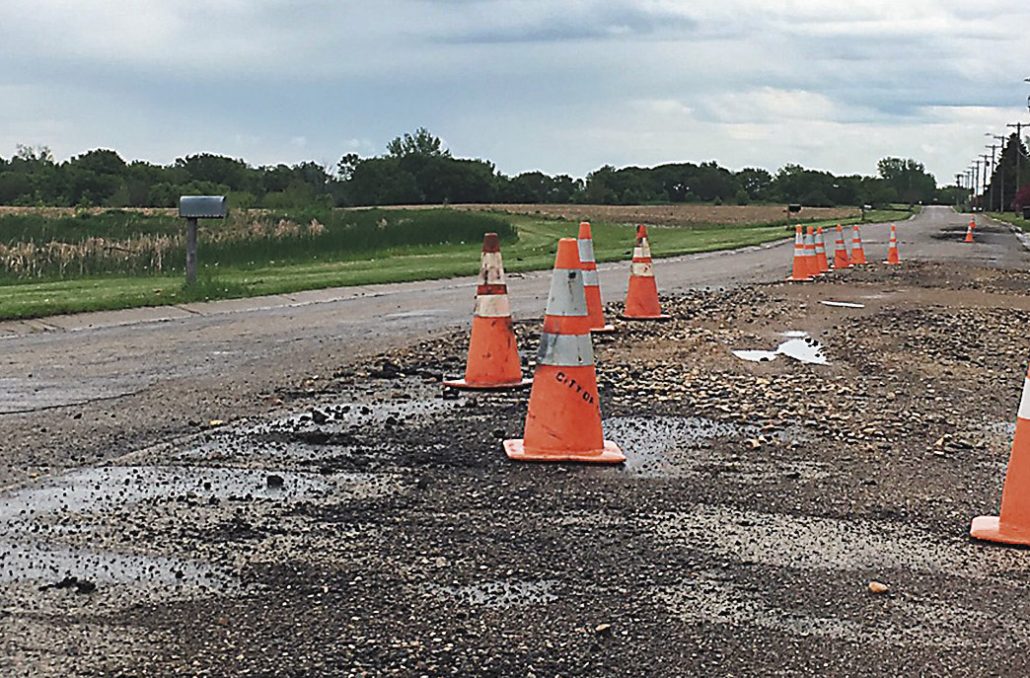
Below-the-surface issues plague road
Discussion at a May EDA meeting centered around the very real potential for a future housing development along Front St., on the southern side of the town. However, talks concerning Front St. at last week’s city council meeting weren’t nearly as positive.
Tracy Public Works Director Shane Daniels shared with the council an underlying problem on Front St. that stems from an old county tile that runs from west to east under the road. After and during heavy rains, the tile surcharges (carries an excess load or overload), and that has played a large role in the significant deterioration of some areas of the road.
“The county is looking into it to see if there is some way we could relieve the water, and they could assist us in increasing the size of our current ditch and kind of divert some of the water there, so it’s not surcharging the old tile anymore,” Daniels said.
Daniels said that no matter what happens, the tile needs to be replaced before a new surface would be put on. The tile doesn’t run straight like the road does. It runs at an angle and eventually shoots to the southeast before curling back into the county ditch on the east side of Center St.
“There’s the potential we could see some money from FEMA for frost heaves, but it’s kind of stupid to throw money at it if it’s going to happen again,” Daniels said. “The way it has been raining, I’m sure it’s surcharging now. Right now, we’re just trying to make the best of it with what we have.”
Daniels said at last Tuesday’s council meeting that it could be a couple of weeks before he hears back from the county on the issue.
The water issue was at its peak last spring and summer when the ditch would fill up quickly. The water would rise, he said, and it would take debris like corn stalks and dump it into the catch basin when the road floods.
“The doesn’t help the county tile, because it actually has an intake by the Alliance Church, so when that fills up it surcharges the tile even more and it’s a snowball effect,” Daniels said.
The tile goes all the way back to the early 1900s, Daniels said. There was a recent repair done at the Main St. intersection, after damage resulted from a collapsed tile.
“That tile was probably a third or better full of debris,” said Daniels. “You got a 12-inch pipe that was running at just over half its capacity.
City Administrator Kris Ambuehl said the county has the levy authority over the tile and that it does have funds for tile repair.
“They have to decide if it’s going to be a repair or a replacement,” he said. “To get some financial assistance, we want to wait for the county to come up with their decision, and we also want to record everything … because we might be able to get some FEMA dollars.”
Ambuehl said he knows residents who use that street daily want to see something done sooner rather than later, but he also believes they would want the city to do its due diligence when it comes to how to best remedy the situation.
Councilmember Tony Peterson noted that Front St. was a gravel road back in the 1970s.
•••
There are three utility meters that still need to be converted from the old-style system, Ambuehl said. One hasn’t been done because of a scheduling conflict, one has called to set up an appointment, and one is “an absolute holdout and has told us they are not going to participate” Ambuehl said.
Ambuehl said if there isn’t a change of heart from the homeowner, the 120-day countdown will begin before a shut-off at the residence is initiated. Ambuehl said he would reach out to the city attorney so an official notice to the homeowner can be drafted.
In March, the city announced it was ramping up efforts to get 100% of its utility customers hooked up with new “radio read” water meters. Residents who refuse to allow the meters to be installed face a $500 fine and an eventual shut-off of water service, according to an enforcement plan recommended by Kris Ambuehl that was approved by the city council in early March. The Tracy Public Works Dept. has been installing new water meters for more than 10 years; a city employee in a truck can read the meters remotely. The newer-style meters are more accurate than old units, save labor for city staff, and can help detect leaks in the system.
•••
Ambuehl said the City should soon start seeing some FEMA money come in as part of disaster recovery from the July 3, 2018, flood — perhaps in the next four to five weeks. As far as help for the recovery from this spring’s ice storm, Ambuehl anticipates “that we will met the threshold for the recent disaster. I think we’ll be seeing some relief from the storm. It’s obviously not as critical as it was last year as far as the dollar amount; I recorded $58,000 in damages, without the road damages.”
•••
Daniels shared the final tally of the city’s Spring Clean-up Day on May 18:
• Mattresses — cost of disposal: $210
• Tires — $200.75
• Appliances and electronics — $1,860
• General garbage — $1,328.63
• The total expense to the city was $3,599.38. The city brought in $1,743, leaving a total expense of $1,856.38.
“I’d like to thank the volunteers who helped,” Tracy Mayor Anthony Dimmers said.
